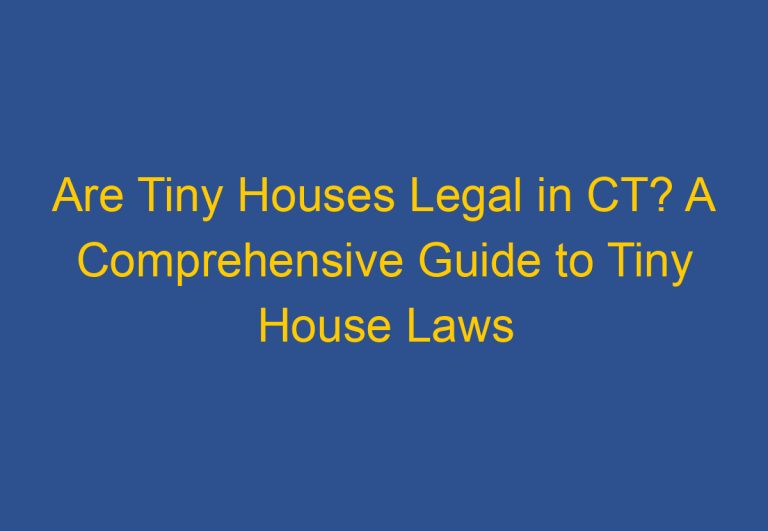How Much Is a Tiny House in California: A Comprehensive Guide
Tiny houses have become increasingly popular in California, especially among those who are looking for an affordable and minimalist lifestyle. These small homes are typically built on wheels, making them portable and allowing homeowners to travel with ease. But how much does a tiny house actually cost in California?

According to research, the cost of a tiny house in California can vary greatly depending on the size and features of the home. A basic, no-frills tiny house can start as low as $15,000, while a larger, more luxurious tiny house can cost upwards of $100,000. On average, the cost of a tiny house in California is around $45,000.
Despite the relatively high cost of tiny houses in California, they are still considered an affordable housing option for many people. In a state where the cost of living is high and housing prices are skyrocketing, tiny houses offer a more affordable and sustainable alternative for those who are looking to downsize and simplify their lives.
Understanding Tiny House Costs in California

Price Range and Factors Influencing Cost
The cost of a tiny house in California can vary significantly depending on various factors. According to recent research, the average cost of a tiny house in California is around $45,000. However, this cost can go up to $100,000 or more for a larger, more luxurious home. On the other hand, a basic tiny house can start as low as $15,000.
Some of the factors that influence the cost of a tiny house in California include the size of the house, the materials used, the appliances installed, and the location of the house. For example, building a tiny house in Los Angeles can be more expensive than building one in a rural area due to the higher cost of land and materials. Additionally, the cost of permits and zoning requirements can also add up to the overall cost of the tiny house.
Tiny House vs Traditional Homes: Affordability
One of the main reasons why people choose to live in a tiny house is because of its affordability. In California, the cost of traditional homes can be exorbitant, making it difficult for many people to own a home. However, a tiny house offers an affordable alternative to traditional homes.
Compared to traditional homes, tiny houses are smaller and require fewer materials, which makes them less expensive to build. Additionally, tiny houses are more energy-efficient, which can help homeowners save money on utility bills in the long run.
Financing Options for Tiny House Buyers
While tiny houses are more affordable than traditional homes, they still require a significant upfront investment. Fortunately, there are several financing options available for tiny house buyers in California.
One option is to take out a personal loan or an RV loan to finance the tiny house. Personal loans offer a fixed interest rate and a set repayment term, making it easier for buyers to budget their finances. RV loans, on the other hand, are specifically designed for recreational vehicles, including tiny houses.
Another financing option is to save up for the tiny house. This can take longer, but it allows buyers to avoid taking on debt and paying interest. Additionally, some tiny house builders offer financing options or rent-to-own programs, which can make it easier for buyers to afford a tiny house.
In conclusion, understanding the costs of a tiny house in California is essential for anyone considering this alternative lifestyle. By considering factors such as size, materials, location, and financing options, buyers can make an informed decision and find a tiny house that fits their budget and lifestyle.
Lifestyle and Legal Considerations

Zoning Regulations and Legal Status
When it comes to tiny houses in California, zoning regulations and legal status are two crucial factors to consider. The state has strict building codes and regulations that govern the construction and placement of tiny homes. It is essential to research the zoning regulations in the area where you plan to build or park your tiny home. Some cities and counties have more lenient zoning regulations than others.
In California, tiny homes are considered either ADUs (Accessory Dwelling Units) or RVs (Recreational Vehicles). The legal status of your tiny home will depend on how it is classified. If your tiny home is considered an ADU, you will need to obtain the necessary permits and meet the building codes and regulations. If your tiny home is considered an RV, you will need to comply with the state’s RV regulations.
Living the Tiny House Lifestyle
Living in a tiny house is not just about downsizing; it is a lifestyle choice that requires a certain level of flexibility, sustainability, and eco-friendliness. Tiny house living can be a great way to reduce your carbon footprint and live a more environmentally friendly lifestyle. It can also be an opportunity to explore new DIY projects and learn new skills.
However, living in a tiny house also requires a certain level of security and privacy. It is essential to research the different security measures you can take to ensure your safety and the safety of your property. Additionally, living in a tiny house can be challenging for some people, especially those who are not used to compact living. It is important to consider the lifestyle changes that come with tiny house living before making the decision to downsize.
Community and Support for Tiny House Owners
One of the most significant benefits of tiny house living is the sense of community and support that comes with it. There are many tiny house communities in California where you can connect with other tiny house owners and share resources and knowledge. These communities can be a great source of support and inspiration for those who are new to tiny house living.
Moreover, there are many organizations and groups that offer resources and support for tiny house owners. These groups can provide information on zoning regulations, permits, sustainable materials, and DIY construction. They can also offer guidance on off-grid living, environmentally friendly practices, and other aspects of tiny house living.
In conclusion, when considering the cost of a tiny house in California, it is essential to take into account the zoning regulations and legal status, the lifestyle changes required, and the sense of community and support available to tiny house owners. With careful research and planning, living in a tiny house can be a fulfilling and sustainable lifestyle choice.
Frequently Asked Questions

What is the average cost of a tiny house for sale in California?
The average cost of a basic tiny house in California starts at around $50,000. However, the cost can vary depending on the size, materials used, and other factors. Some high-end models can cost up to $150,000 or more.
What are the price ranges for tiny homes with land included in California?
The price of a tiny home with land in California can vary widely depending on the location and the size of the property. In general, the cost of land in California is high, so expect to pay a premium for a tiny home with land. Prices can range from $100,000 to $500,000 or more.
How much does it typically cost to rent a tiny house in California?
The cost to rent a tiny house in California can vary depending on the location, size, and amenities. In general, you can expect to pay between $1,000 and $2,000 per month for a tiny house rental in California.
What are the legalities surrounding tiny house living in California?
Tiny houses are legal in California, but the regulations and rules vary depending on the local zoning and building codes. Before building or buying a tiny house in California, it’s important to research the regulations in your specific area. Some areas may have specific requirements for minimum square footage, while others restrict where tiny houses are parked.
Can you purchase a used tiny home in California, and what might that cost?
Yes, you can purchase a used tiny home in California. The cost of a used tiny home can vary depending on the age, condition, and features of the home. In general, you can expect to pay between $20,000 and $80,000 for a used tiny home in California.
Is living in a tiny house in California more affordable compared to traditional housing?
Living in a tiny house in California can be more affordable than traditional housing in some cases. However, the cost savings depend on a variety of factors, including the size and location of the tiny house, the cost of land, and the cost of utilities. It’s important to carefully consider all of the costs before deciding if living in a tiny house is the right choice for you.






